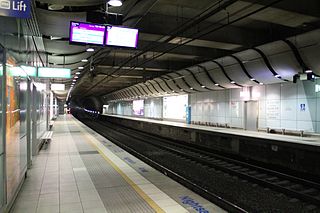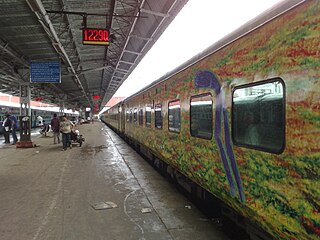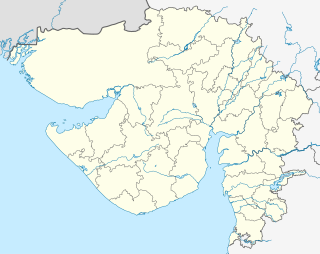
Transport for London (TfL) is a local government body responsible for the transport system in Greater London, England. Its head office is 55 Broadway in the City of Westminster.

Rail transport is an important mode of transport in India.

The Airport Link is a railway line in Australia connecting Sydney Airport to the Central Business District and the south-western suburbs of Sydney. With the exception of Wolli Creek, the Airport Line stations are operated by a private company, the Airport Link Company, as part of a public private partnership. The contract allows the company to charge a surcharge on top of the normal fare. The line is served by Sydney Trains T8 Airport & South line services.

The Manila Light Rail Transit System Line 2, also known as MRT Line 2, MRT-2, or Megatren, is a rapid transit line in Metro Manila in the Philippines, generally running in an east-west direction along the Radial Road 6 and a portion of the Circumferential Road 1. Although operated by the Light Rail Transit Authority, resulting in its being called "LRT-2", it is actually a heavy rail, rapid transit system owing to its use of electric multiple units instead of the light rail vehicles used in earlier lines and is presently the only line utilizing such vehicles in the country. Envisioned in the 1970s as part of the Metropolitan Manila Strategic Mass Rail Transit Development Plan, the eleven-station, 13.8-kilometer (8.6 mi) line was the third rapid transit line to be built in Metro Manila when it started operations in 2003. It is operated by the Light Rail Transit Authority (LRTA), a government-owned and controlled corporation attached to the Department of Transportation (DOTr) under an official development assistance scheme.

Pawan Kumar Bansal is an Indian National Congress politician and a former minister in the Manmohan Singh government. He represented Chandigarh constituency in the 15th Lok Sabha of India. He served as Minister of Railways from 28 October 2012 to 10 May 2013.
Trainline, formerly branded Thetrainline.com, is an independent digital rail and coach platform. It sells tickets through its website, by telephone, and through its mobile app which is available on iOS, Windows Phone and Android platforms.
India does not have any railways that can be classified as high-speed rail (HSR) by international standards, i.e. railways with operational speeds exceeding 200 km/h (120 mph). The current fastest train in India is the Train 18 with a top speed of 180 km/h (110 mph), which runs between New Delhi and Varanasi.
The Western Railway Elevated Corridor, also known as the Oval Maidan-Virar elevated corridor, was a proposed rapid transit corridor that would have run along the same alignment as the Western Line of the Mumbai Suburban Railway, and link Oval Maidan with Virar.

Duronto Express is a category of long-distance non stop source to destination trains run by the Indian Railways. Initially these trains did not have any ticketing stops between the origin and the destination, but since January 2016 it is possible to book tickets from those technical stops. "Duronto" means "restless" in Bangla. These trains' coaches have characteristic yellow-green livery. Duronto Express services connect the several metros and major state capitals of India.

Pune Junction railway station is the main railway station of Pune. It is a railway junction on the Mumbai–Chennai line. The Pune–Bengaluru line starts from here.

The Delhi Metro is a rapid transit system serving Delhi and its satellite cities of Bahadurgarh, Ballabhgarh, Faridabad, Ghaziabad, Gurgaon and Noida in the National Capital Region of India. By far the largest and busiest metro in India, and second oldest after the Kolkata Metro it is the world's 9th longest metro system and 16th largest by ridership. The network consists of eight colour-coded regular lines, running 327 kilometres (203 mi) serving 236 stations. The system has a mix of underground, at-grade, and elevated stations using both broad-gauge and standard-gauge. Delhi Metro operates over 2,700 trips daily, starting at around 05:00 and ending at 23:30 hrs. In 2016-17, the Delhi Metro had an average daily ridership of 2.76 million passengers and a cumulative ridership of over 1 billion passengers yearly.
Mumbai–Ahmedabad High Speed Rail Corridor is a high-speed rail line currently under construction. When completed, it will connect the cities of Ahmedabad, Gujarat, and India's economic hub Mumbai. It will be India's first high-speed rail line.

Sydney Trains is the suburban passenger rail network serving the city of Sydney, New South Wales, Australia. The network is a hybrid suburban-commuter rail system with a central underground core that covers over 815 km (506 mi) of track and 178 stations over eight lines. It has metro-equivalent train frequencies of every three minutes or better in the underground core, 5–10 minutes at most major stations all day and 15 minutes at most minor stations all day. During weekend services trains are less frequent with headways of upwards of a half-hour on outer stations with frequencies of less than 10 minutes in the underground core.
Rail Budget of India was the Annual Financial Statement of the state-owned Indian Railways, which handles rail transport in India. It was presented every year by the Minister of Railways, representing the Ministry of Railways, in the Parliament.
The Gaya–Kiul line is a railway line connecting Gaya on the Howrah-Gaya-Delhi line and Kiul on the Howrah-Delhi main line both in the Indian state of Bihar.
The Suvidha Express also called as Premium Express series of trains were introduced by Indian Railways in 2014 for the 1st time which is operated in busiest routes.. They were intended to follow dynamic pricing in fares similar to that of airlines contrary to the standard one fare for one class of travel generally followed by Indian Railways. Priority of Premium trains are above Superfast and Mail/Express trains like Shatabdi Express, Duronto Express and Rajdhani Express.
The 22461/22462 Shri Shakti Express is an AC Superfast Express Train run by Indian Railways between New Delhi and Shri Mata Vaishno Devi Katra railway stations in India.

2015 Railway Budget of India refers to the Railway Budget of the Indian Railways in the fiscal year 2015–16. The budget was presented by the Railway Minister Suresh Prabhu in the Parliament on 26 February 2015.

2016 Railway Budget of India refers to the Railway Budget of the Indian Railways in the fiscal year 2016–17. The budget was presented by the Railway Minister Suresh Prabhu in the Parliament on 25 February 2016. It was the final Railway Budget of India as after this budget, the Railway Budget got merged with the Union Budget of India.


















